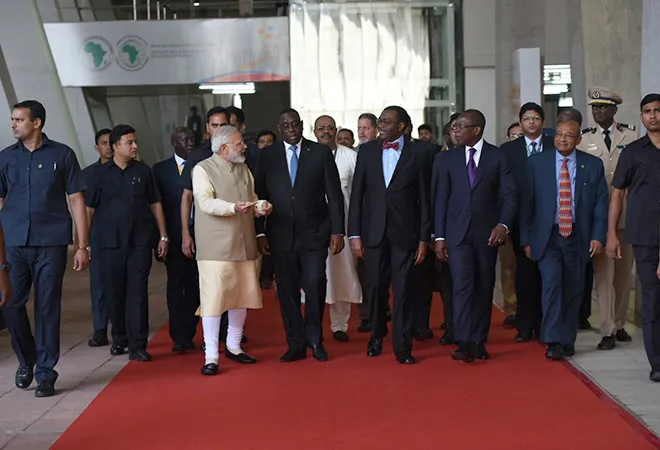-
CENTRES
Progammes & Centres
Location
The general meeting of the African Development Bank in Gandhinagar could improve India’s engagement with a continent where it has lagged behind China in project execution.

India joined the African Development Bank (AfDB) in 1983. However, it is only this year, 2017, that it is hosting the annual meetings of the AfDB and its sister institutions, including of finance ministers of member countries, who comprise the AfDB board of governors.
The meetings, which open in Gandhinagar today, are important for India for more than one reason. First, they will be seen as a logical follow-up to the India-Africa Forum Summit in New Delhi in 2015, attended by 40 African heads of state or government and representatives of all 54 countries from the continent. Second, after India’s boycott of China’s Belt and Road forum, there will be a keenness to understand the Narendra Modi government’s approach to its own connectivity, infrastructure and developmental projects, particularly in geographies where it competes with Beijing.
The AfDB meetings will be a useful reckoner in this regard. The five-day event will see 2,800 delegates arriving from Africa and elsewhere. The Gujarat government, keen to exploit opportunities for local business, has seen registration by 5,000 Gujarat-based business executives – representing industries as far apart as education and mining, health-care/pharmaceuticals and energy.
Like the Make in India Forum that was held in Mumbai in 2016, this is another example of the Modi government’s determination to take marquee business and economy events outside the national capital, and encourage individual states to up their game. Yet, that is a collateral story.
The major theme of the AfDB week will be giving teeth to India’s engagement with a continent where, despite goodwill, it has hitherto lagged behind China in project execution. India-Africa trade doubled in the five-year period ending 2014-15, to reach US$ 72 billion. In the following year, it fell sharply to US$ 56 billion, a direct consequence of the end of the commodities boom that had led to a surge in Indian resources imports.
Even so, Indian private sector presence in Africa is significant. Investments amount to US$ 35 billion and range from automobile manufacture to drugs and pharmaceuticals, textiles to IT services, water treatment to petroleum refining. Africa remains a manufacturing frontier. Unlike China, Indian state agencies are more open to building local capacities in Africa. As an example, India’s Exim Bank has helped incubate similar institutions in five countries.
In Gandhinagar, India is expected to announce an agreement with the AfDB to route about 20 per cent of the US$ 10 billion that it has set aside for developmental credit to Africa. Some US$ 2 billion will be given to the AfDB to deploy, with the Bank acting as a sort of co-guarantor and co-lender, and giving local ownership and design to projects. Of course, project execution will still be undertaken by Indian companies through transparent contracting.
Also expected to be discussed is the Japanese and Indian proposal for the “Asia-Africa Growth Corridor”. Details are being finalised and a key announcement is expected only when the Japanese prime minister visits India later this year. In Gandhinagar, however, the Japanese deputy finance minister will be part of a dialogue on how India and Japan can work with and in Africa.
This is not a one-off. The Modi government is increasingly seeing value in combining with key partner countries – Germany, the United Kingdom, the United States, France – to pool resources and technical skills in Africa and make a bigger impact. This is a gradual shift from the “go it alone” thinking that had initially influenced the Ministry of External Affairs’ Development Partnership Administration. The Japanese blueprint includes investments in the blue economy, on the east coast of Africa that is washed by the waters of the Indian Ocean, and an SEZ in Mombasa (Kenya).
Finally, of course, Africa is crucial to the India-fostered International Solar Alliance (ISA). Over a dozen of the ISA’s 24 members are from Africa, the continental powerhouse of solar energy. Another 10 odd countries may choose Gandhinagar to indicate their willingness to sign on. That should give India some satisfaction.
This commentary originally appeared in Hindustan Times.
The views expressed above belong to the author(s). ORF research and analyses now available on Telegram! Click here to access our curated content — blogs, longforms and interviews.